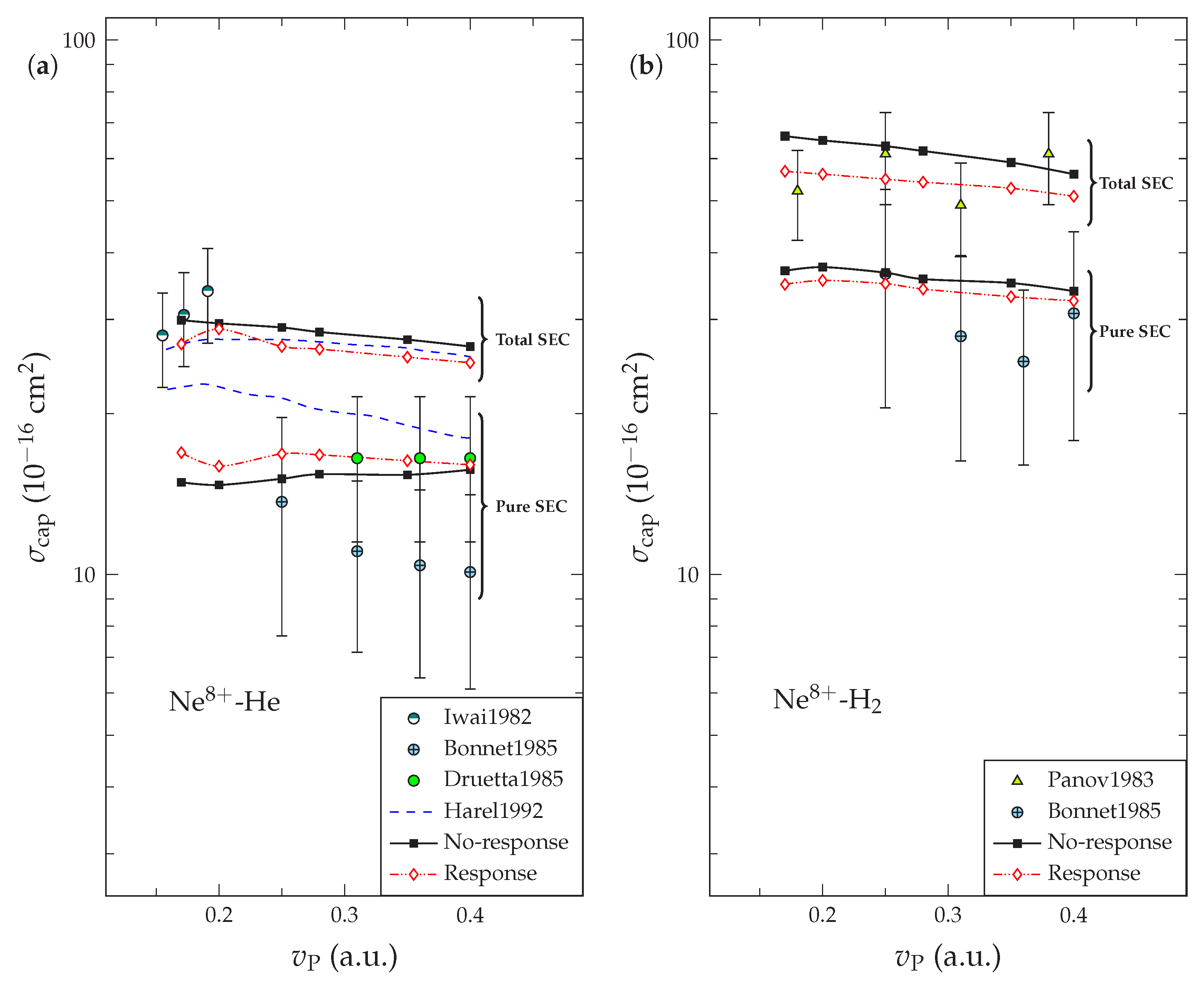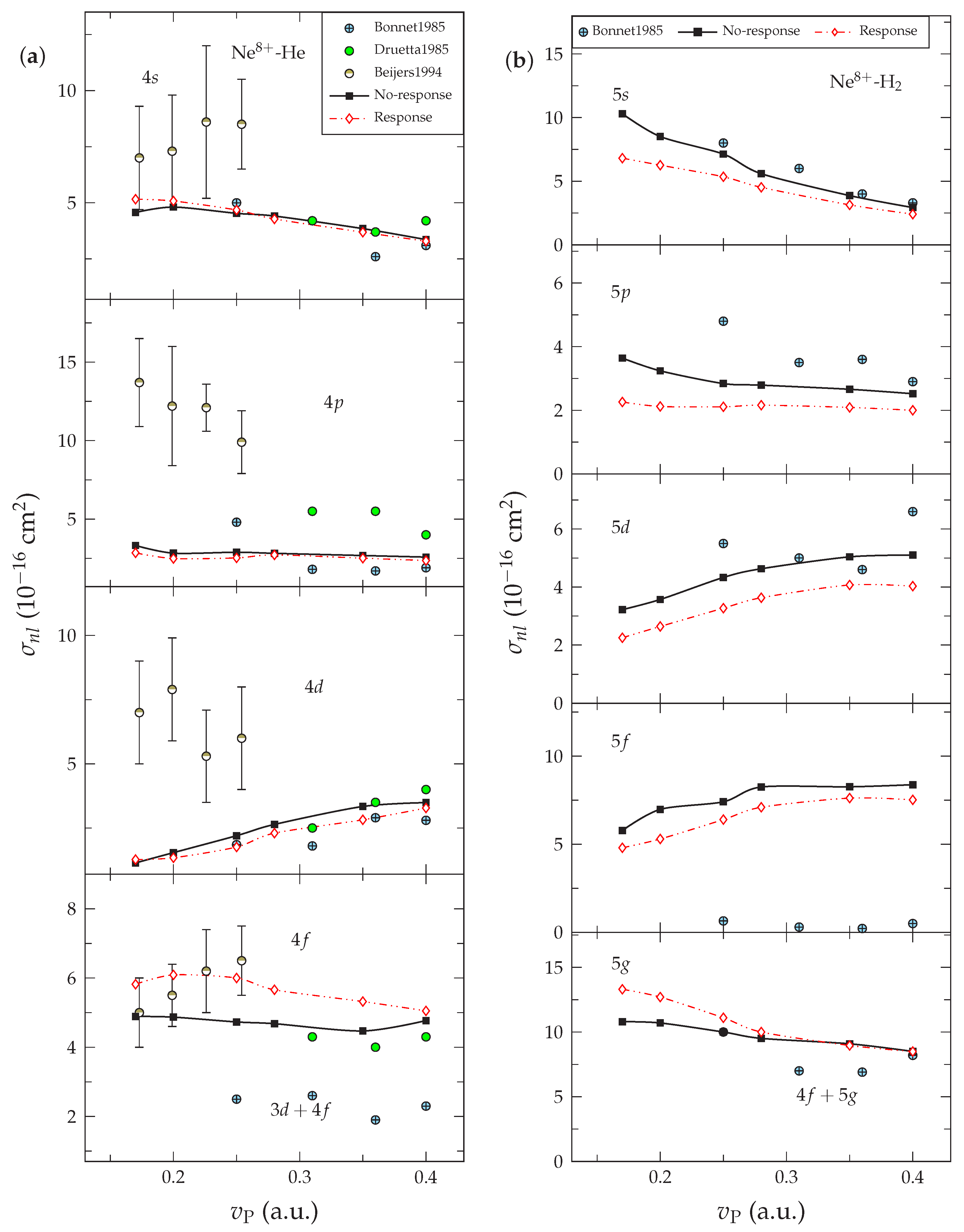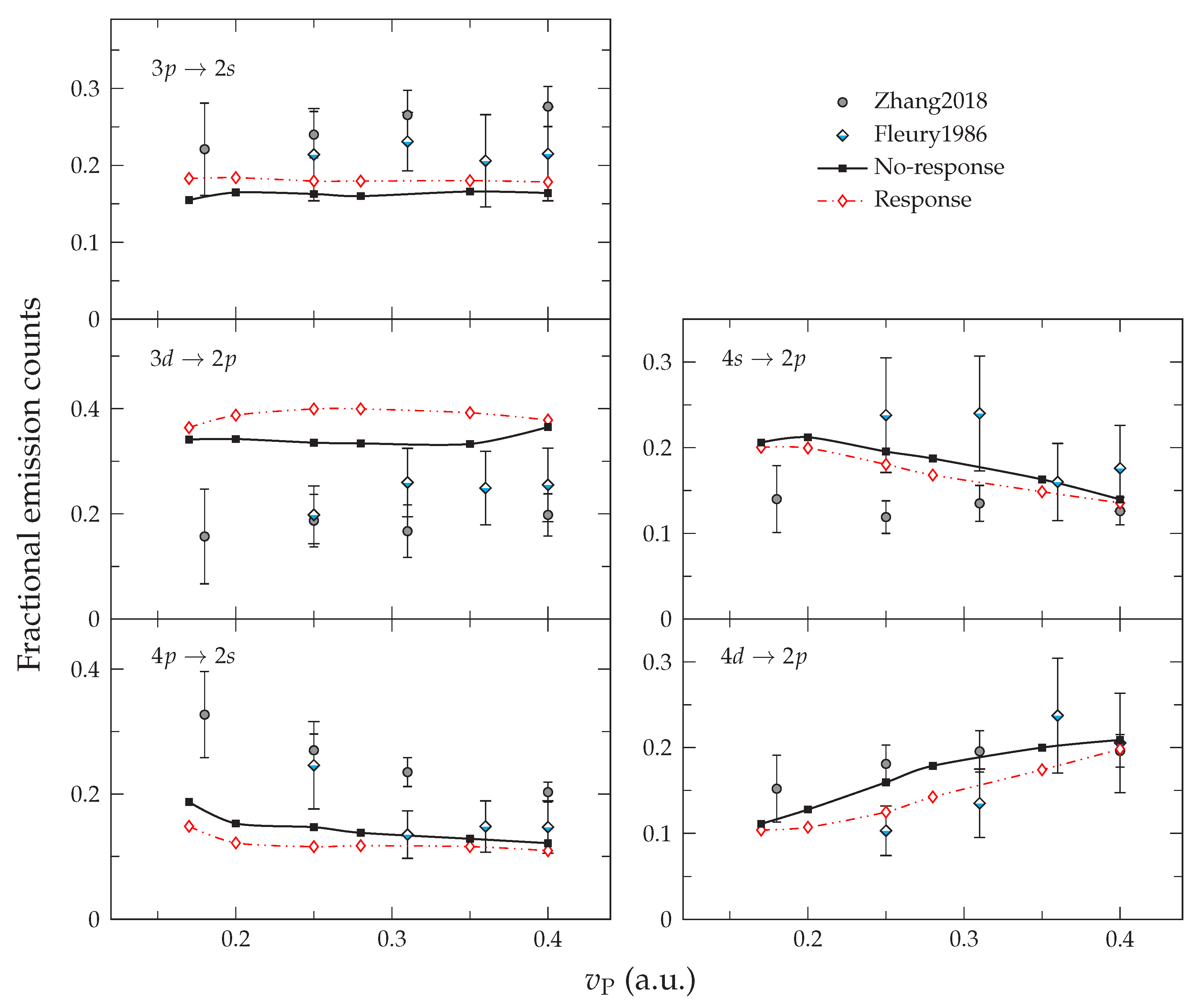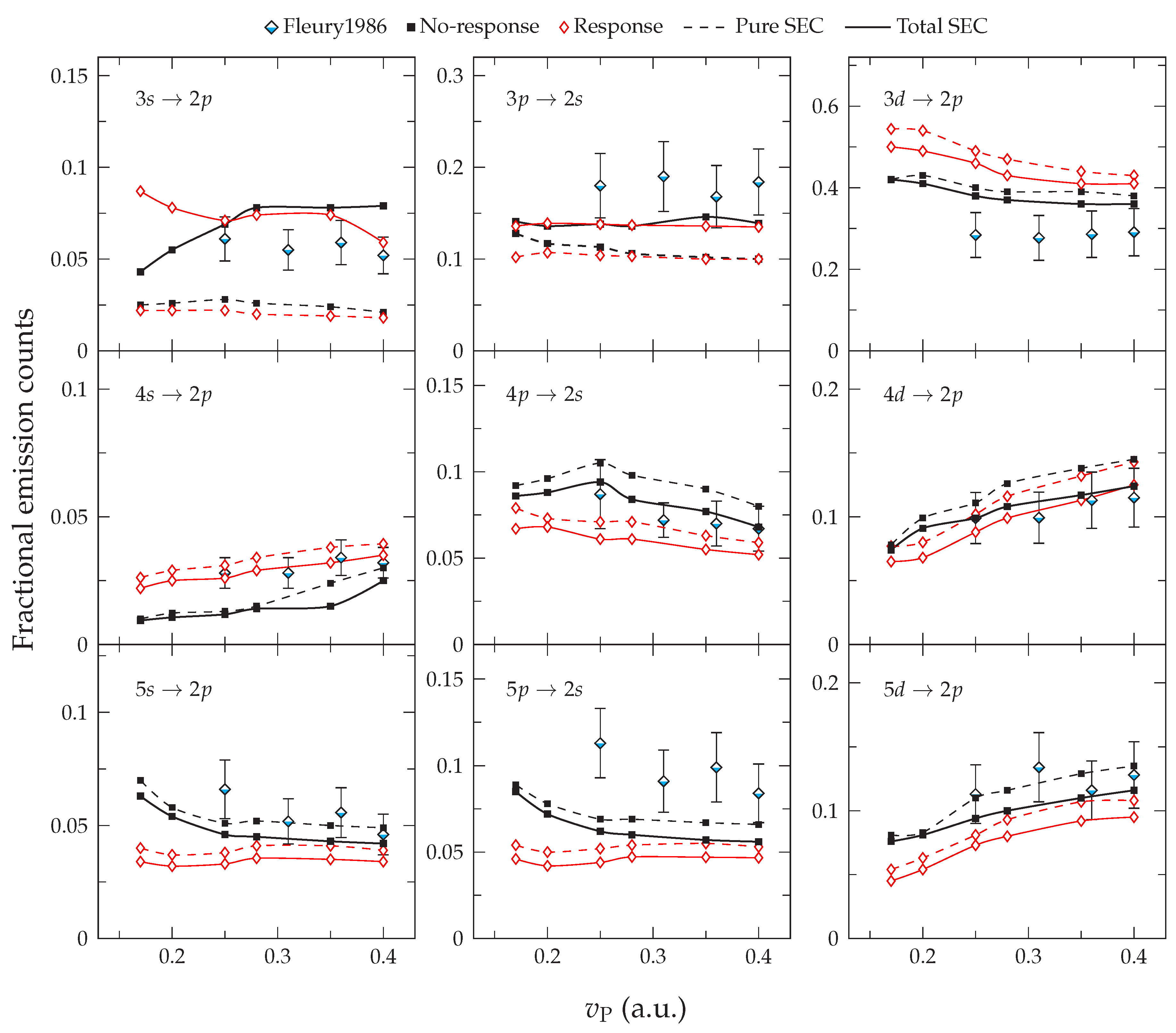Capture Cross Sections and Radiative Emission-Line Strengths for Slow Ne8+ Collisions with He and H2
Abstract
1. Introduction
2. Theoretical Approach
3. Results and Discussion
3.1. Capture Cross Sections
3.2. Line-Emission Results
4. Conclusions
Author Contributions
Funding
Acknowledgments
Conflicts of Interest
References
- Lisse, C.M.; Dennerl, K.; Englhauser, J.; Harden, M.; Marshall, F.E.; Mumma, M.J.; Petre, R.; Pye, J.P.; Ricketts, M.J.; Schmitt, J.; et al. Discovery of X-ray and Extreme Ultraviolet Emission from Comet C/Hyakutake 1996 B2. Science 1996, 274, 205. [Google Scholar] [CrossRef]
- Beiersdorfer, P.; Olson, R.E.; Brown, G.V.; Chen, H.; Harris, C.L.; Neill, P.A.; Schweikhard, L.; Utter, S.B.; Widmann, K. X-Ray Emission Following Low-Energy Charge Exchange Collisions of Highly Charged Ions. Phys. Rev. Lett. 2000, 85, 5090. [Google Scholar] [CrossRef] [PubMed]
- Cravens, T.E. X-ray Emission from Comets. Science 2002, 296, 1042–1045. [Google Scholar] [CrossRef] [PubMed]
- Cravens, T.E. Heliospheric X-ray Emission Associated with Charge Transfer of the Solar Wind with Interstellar Neutrals. Astrophys. J. 2000, 532, L153. [Google Scholar] [CrossRef] [PubMed]
- Koutroumpa, D.; Lallement, R.; Kharchenko, V.; Dalgarno, A.; Pepino, R.; Izmodenov, V.; Quémerais, E. Charge-transfer induced EUV and soft X-ray emissions in the heliosphere. Astron. Astrophys. 2006, 460, 289–300. [Google Scholar] [CrossRef]
- Krasnopolsky, V.A. CXO X-ray spectroscopy of comets and abundances of heavy ions in the solar wind. Icarus 2015, 247, 95–102. [Google Scholar] [CrossRef]
- Cumbee, R.S.; Henley, D.B.; Stancil, P.C.; Shelton, R.L.; Nolte, J.L.; Wu, Y.; Schultz, D.R. Can charge exchange explain anomalous soft x-ray emission in the Cygnus loop? Astrophys. J. Lett. 2014, 787, L31. [Google Scholar] [CrossRef]
- Cumbee, R.S.; Mullen, P.D.; Lyons, D.; Shelton, R.L.; Fogle, M.; Schultz, D.R.; Stancil, P.C. Charge Exchange X-Ray Emission due to Highly Charged Ion Collisions with H, He, and H2: Line Ratios for Heliospheric and Interstellar Applications. Astrophys. J. 2017, 852, 7. [Google Scholar] [CrossRef]
- Ali, R.; Neill, P.A.; Beiersdorfer, P.; Harris, C.L.; Schultz, D.R.; Stancil, P.C. Critical Test of Simulations of Charge-Exchange-Induced X-ray Emission in the Solar System. Astrophys. J. Lett. 2010, 716, L95. [Google Scholar] [CrossRef]
- Wu, Y.; Stancil, P.C.; Schultz, D.R.; Hui, Y.; Liebermann, H.P.; Buenker, R.J. Theoretical investigation of total and state-dependent charge exchange in O6+ collisions with atomic hydrogen. J. Phys. B 2012, 45, 235201. [Google Scholar] [CrossRef]
- Machacek, J.R.; Mahapatra, D.P.; Schultz, D.R.; Ralchenko, Y.; Moradmand, A.; El Ghazaly, M.O.A.; Chutjian, A. Solar-Wind Ion-Driven X-ray Emission from Cometary and Planetary Atmospheres: Measurements and Theoretical Predictions of Charge-Exchange Cross-Sections and Emission Spectra for O6++ H2O, CO, CO2, CH4, N2, NO, N2O, and Ar. Astrophys. J. 2015, 809, 75. [Google Scholar] [CrossRef]
- Ali, R.; Beiersdorfer, P.; Harris, C.L.; Neill, P.A. Charge-exchange x-ray spectra: Evidence for significant contributions from radiative decays of doubly excited states. Phys. Rev. A 2016, 93, 012711. [Google Scholar] [CrossRef]
- Bonnet, J.J.; Fleury, A.; Bonnefoy, M.; Politis, M.F.; Chassevent, M.; Bliman, S.; Dousson, S.; Hitz, D. Electron capture into different (nl) states in slow collisions of Ne8+ projectiles on He and H2 targets. J. Phys. B 1985, 18, L23–L27. [Google Scholar] [CrossRef]
- Druetta, M.; Mayo, M.; Bliman, S.; Martin, S.; Hitz, D.; Dousson, S.; Desesquelles, J. Etude spectroscopique de la collision d’échange de charge entre Ne8+ et He. J. Physique Lett. 1985, 46, 869–873. [Google Scholar] [CrossRef]
- Beijers, J.P.M.; Hoekstra, R.; Morgenstern, R. State-selective charge transfer between He-like ions and He. Phys. Rev. A 1994, 49, 363–373. [Google Scholar] [CrossRef] [PubMed]
- Fleury, A.; Debernardi, J.; Bonnefoy, M.; Bliman, S.; Bonnet, J.J.; Chassevent, M. A simple soft X-ray (1 < λ < 11 nm) spectrometer for relative line intensity measurements in charge exchange studies. Nucl. Instrum. Methods Phys. Res. Sect. B 1986, 14, 353–359. [Google Scholar]
- Harel, C.; Jouin, H. Double capture into autoionizing states in Iq+ -He collisions at low impact energies. J. Phys. B 1992, 25, 221–237. [Google Scholar] [CrossRef]
- Politis, M.F.; Jouin, H.; Bonnefoy, M.; Bonnet, J.J.; Chassevent, M.; Fleury, A.; Bliman, S.; Harel, C. Relative (n,l) populations following electron capture by low energy N7+, O8+ and Ne8+ ions from two-electron targets (H2, He). J. Phys. B 1987, 20, 2267–2279. [Google Scholar] [CrossRef]
- McCammon, D.; Barger, K.; Brandl, D.E.; Brekosky, R.P.; Crowder, S.G.; Gygax, J.D.; Kelley, R.L.; Kilbourne, C.A.; Lindeman, M.A.; Porter, F.S.; et al. The X-ray Quantum Calorimeter Sounding Rocket Experiment: Improvements for the Next Flight. J. Low Temp. Phys. 2008, 151, 715–720. [Google Scholar] [CrossRef]
- Zhang, R.T.; Wulf, D.; Jaeckel, F.; McCammon, D.; Seely, D.G.; Andrianarijaona, V.M.; Cumbee, R.S.; Stancil, P.C.; Havener, C.C. High-resolution charge exchange X-ray emission at solar wind velocities. 2018. submitted. [Google Scholar]
- Zhang, R.T. (Oak Ridge National Laboratory, Oak Ridge, TN, USA). Personal communication, 2018.
- McGuire, J.H.; Weaver, L. Independent electron approximation for atomic scattering by heavy particles. Phys. Rev. A 1977, 16, 41. [Google Scholar] [CrossRef]
- Jain, A.; Lin, C.D.; Fritsch, W. Electron capture in C6++ He and O8++ He collisions at intermediate energies in the atomic-orbital-expansion method. Phys. Rev. A 1986, 34, 3676–3683. [Google Scholar] [CrossRef]
- Shingal, R.; Lin, C.D. Calculations of two-electron transition cross sections between fully stripped ions and helium atoms. J. Phys. B 1991, 24, 251–264. [Google Scholar] [CrossRef]
- Chen, Z.; Shingal, R.; Lin, C.D. State-selective double capture in collisions of bare ions with helium atoms at low energies. I. Total cross sections. J. Phys. B 1991, 24, 4215–4230. [Google Scholar] [CrossRef]
- Chen, Z.; Lin, C.D. Double electron capture and the angular distribution of ejected electrons in Ne8+-He collisions. Phys. Rev. A 1993, 48, 1298–1307. [Google Scholar] [CrossRef] [PubMed]
- Errea, L.F.; Gorfinkiel, J.D.; Harel, C.; Jouin, H.; Macías, A.; Méndez, L.; Pons, B.; Riera, A. Model potential treatment of C4++H2 collisions at low impact energies. J. Phys. B 2000, 33, 3107. [Google Scholar] [CrossRef]
- Zapukhlyak, M.; Kirchner, T.; Lüdde, H.J.; Knoop, S.; Morgenstern, R.; Hoekstra, R. Inner- and outer-shell electron dynamics in proton collisions with sodium atoms. J. Phys. B 2005, 38, 2353. [Google Scholar] [CrossRef]
- Zapukhlyak, M.; Kirchner, T.; Hasan, A.; Tooke, B.; Schulz, M. Projectile angular-differential cross sections for transfer and transfer excitation in proton collisions with helium. Phys. Rev. A 2008, 77, 012720. [Google Scholar] [CrossRef]
- Knoop, S.; Fischer, D.; Xue, Y.; Zapukhlyak, M.; Osborne, C.J.; Ergler, T.; Ferger, T.; Braun, J.; Brenner, G.; Bruhns, H.; et al. Single-electron capture in keV Ar 15+…18++He collisions. J. Phys. B 2008, 41, 195203. [Google Scholar] [CrossRef]
- Röhrbein, D.; Kirchner, T.; Fritzsche, S. Role of cascade and Auger effects in the enhanced population of the C3+(1s2s2p4P) states following single-electron capture in C4+(1s2s3S)-He collisions. Phys. Rev. A 2010, 81, 042701. [Google Scholar] [CrossRef]
- Schenk, G.; Kirchner, T. Multiple ionization of neon atoms in collisions with bare and dressed ions: A mean-field description considering target response. Phys. Rev. A 2015, 91, 052712. [Google Scholar] [CrossRef]
- Salehzadeh, A.; Kirchner, T. Strong multiple-capture effect in slow Ar 17+ -Ar collisions: A quantum mechanical analysis. J. Phys. B 2013, 46, 025201. [Google Scholar] [CrossRef]
- Leung, A.C.K.; Kirchner, T. Independent-electron analysis of the x-ray spectra from single-electron capture in Ne10+ collisions with He, Ne, and Ar atoms. Phys. Rev. A 2015, 92, 032712. [Google Scholar] [CrossRef]
- Leung, A.C.K.; Kirchner, T. Analysis of x-ray emission spectra in charge-exchange collisions of C6+ with He and H2. Phys. Rev. A 2016, 93, 052710. [Google Scholar] [CrossRef]
- Leung, A.C.K.; Kirchner, T. Lyman line ratios in charge-exchange collisions of C6+ and O8+ ions with hydrogen and krypton atoms. Phys. Rev. A 2018, 97, 062705. [Google Scholar] [CrossRef]
- Harel, C.; Jouin, H. Electron capture by slow multicharged ions: core effect on final l-distributions. J. Phys. B 1988, 21, 859–883. [Google Scholar] [CrossRef]
- Engel, E.; Vosko, S.H. Accurate optimized-potential-model solutions for spherical spin-polarized atoms: Evidence for limitations of the exchange-only local spin-density and generalized-gradient approximations. Phys. Rev. A 1993, 47, 2800. [Google Scholar] [CrossRef] [PubMed]
- Kirchner, T.; Horbatsch, M.; Lüdde, H.J.; Dreizler, R.M. Time-dependent screening effects in ion-atom collisions with many active electrons. Phys. Rev. A 2000, 62, 042704. [Google Scholar] [CrossRef]
- Kirchner, T.; Horbatsch, M.; Lüdde, H.J. Time-dependent independent-particle model calculation of multiple capture and ionization processes in p-Ar, p¯-Ar, and He2+-Ar collisions. Phys. Rev. A 2002, 66, 052719. [Google Scholar] [CrossRef]
- Chung, H.K.; Braams, B.J.; Bartschat, K.; Csaszar, A.G.; Drake, G.W.F.; Kirchner, T.; Kokoouline, V.; Tennyson, J. Uncertainty Estimates for Theoretical Atomic and Molecular Data. J. Phys. D 2016, 49, 363002. [Google Scholar] [CrossRef]
- Horbatsch, M. A semiclassical time-dependent Hartree model calculation of capture and multiple ionization in heavy ion-Ar collisions. Phys. Lett. A 1994, 187, 185. [Google Scholar] [CrossRef]
- Kirchner, T.; Lüdde, H.J.; Horbatsch, M.; Dreizler, R.M. Quantum-mechanical description of ionization, capture, and excitation in proton collisions with atomic oxygen. Phys. Rev. A 2000, 61, 052710. [Google Scholar] [CrossRef]
- Curtis, L.J. A Diagrammatic Mnemonic for Calculation of Cascading Level Populations. Am. J. Phys. 1968, 36, 1123–1125. [Google Scholar] [CrossRef]
- Younger, S.M.; Wiese, W.L. Theoretical simulation of beam-foil decay curves for resonance transitions of heavy ions. Phys. Rev. A 1978, 17, 1944. [Google Scholar] [CrossRef]
- Fritzsche, S. The ratip program for relativistic calculations of atomic transition, ionization and recombination properties. Comput. Phys. Commun. 2012, 183, 1525–1559. [Google Scholar] [CrossRef]
- Mack, M.; Nijland, J.H.; Straten, P.V.D.; Niehaus, A.; Morgenstern, R. Correlation in double electron capture in collisions of fully stripped ions on He and H2. Phys. Rev. A 1989, 39, 3846. [Google Scholar] [CrossRef]
- Iwai, T.; Kaneko, Y.; Kimura, M.; Kobayashi, N.; Ohtani, S.; Okuno, K.; Takagi, S.; Tawara, H.; Tsurubuchi, S. Cross sections for one-electron capture by highly stripped ions of B, C, N, O, F, Ne, and S from He below 1 keV/amu. Phys. Rev. A 1982, 26, 105–115. [Google Scholar] [CrossRef]
- Panov, M.N.; Basalaev, A.A.; Lozhkin, K.O. Interaction of Fully Stripped, Hydrogenlike and Heliumlike C, N, O, Ne and Ar Ions with H and He Atoms and H2 Molecules. Phys. Scr. 1983, T3, 124–130. [Google Scholar] [CrossRef]
- Boudjema, M.; Cornille, M.; Dubau, J.; Moretto-Capelle, P.; Bordenave-Montesquieu, A.; Benoit-Cattin, P.; Gleizes, A. Investigation of double capture in Ne8++ He, H2, by electron spectroscopy at 80 keV. II. Experimental results. J. Phys. B 1991, 24, 1713–1737. [Google Scholar] [CrossRef]
- Dunseath, K.M.; Crothers, D.S.F. Transfer and ionization processes during the collision of fast H+, He2+ nuclei with helium. J. Phys. B 1991, 24, 5003. [Google Scholar] [CrossRef]
- Roncin, P.; Barat, M.; Laurent, H. Differential Cross-Sections for One- and Two-Electron Capture by Highly Charged Ions (N7+, O7+, O8+, Ne7+, Ne8+) at Low keV Energies. Europhys. Lett. 1986, 2, 371–377. [Google Scholar] [CrossRef]
- Barat, M.; Gaboriaud, M.N.; Guillemot, L.; Roncin, P.; Laurent, H.; Andriamonje, S. Coincident energy gain spectroscopy of electron capture in multiply charged ions colliding with He, H2 and heavy rare-gas targets. J. Phys. B 1987, 20, 5771–5783. [Google Scholar] [CrossRef]
- Mack, M. Electron spectroscopy in collisions with multiply charged ions. Nucl. Instrum. Methods Phys. Res. Sect. B 1987, 23, 74–85. [Google Scholar] [CrossRef]
- Bordenave-Montesquieu, A.; Boudjema, M.; Benoit-Cattin, P.; Gleizes, A.; Moretto-Capelle, P. Q-Dependence of the Double Capture Cross Sections Measured by Electron Spectroscopy at 10 qkeV (q = 4 − 8). Comparison with other Experimental Data. J. Physique Colloques 1989, 50, C1-305–C1-312. [Google Scholar] [CrossRef]
- Janev, R.K.; Winter, H. State-selective electron capture in atom-highly charged ion collisions. Phys. Rep. 1985, 117, 265–387. [Google Scholar] [CrossRef]
- Ullrich, J.; Moshammer, R.; Dorn, A.; Dörner, R.; Schmidt, L.P.H.; Schmidt-Böcking, H. Recoil-ion and electron momentum spectroscopy: Reaction-microscopes. Reports Prog. Phys. 2003, 66, 1463–1545. [Google Scholar] [CrossRef]
| 1. | |
| 2. | When the cross sections of Beijers et al. [15] are added, the sum is similar in magnitude to the total SEC shown in Figure 1a, which conflicts with the pure SEC cross sections from other experimental and theoretical results. For this reason, total cross sections of Beijers et al. [15] are not shown in Figure 1a in order to avoid confusion. |




| a.u. | ||
|---|---|---|
| Ne8+–He | Ne8+–H2 | |
| No-response | 10.8 | 24.1 |
| Response | 9.6 | 19.3 |
| Ref. [17] | ≈7 | |
| Ref. [54] | 10 | 25.6 |
| Ref. [55] | 17 | 36 |
© 2019 by the authors. Licensee MDPI, Basel, Switzerland. This article is an open access article distributed under the terms and conditions of the Creative Commons Attribution (CC BY) license (http://creativecommons.org/licenses/by/4.0/).
Share and Cite
Leung, A.C.K.; Kirchner, T. Capture Cross Sections and Radiative Emission-Line Strengths for Slow Ne8+ Collisions with He and H2. Atoms 2019, 7, 15. https://doi.org/10.3390/atoms7010015
Leung ACK, Kirchner T. Capture Cross Sections and Radiative Emission-Line Strengths for Slow Ne8+ Collisions with He and H2. Atoms. 2019; 7(1):15. https://doi.org/10.3390/atoms7010015
Chicago/Turabian StyleLeung, Anthony C. K., and Tom Kirchner. 2019. "Capture Cross Sections and Radiative Emission-Line Strengths for Slow Ne8+ Collisions with He and H2" Atoms 7, no. 1: 15. https://doi.org/10.3390/atoms7010015
APA StyleLeung, A. C. K., & Kirchner, T. (2019). Capture Cross Sections and Radiative Emission-Line Strengths for Slow Ne8+ Collisions with He and H2. Atoms, 7(1), 15. https://doi.org/10.3390/atoms7010015





